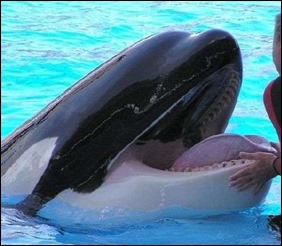A new study, “Tooth Damage in Captive Orcas”, is the first comprehensive, peer-reviewed, quantitative assessment of how extensive tooth damage is among orcas at entertainment facilities. It documents the effects of living in concrete tanks on their teeth, and consequently on their overall health and wellbeing.

It’s already well-known that orcas in entertainment facilities wear down their teeth and break them by chewing on the concrete walls and on the gates that separate their pools. Eventually, these teeth have to be drilled out and then flushed daily to prevent infection.
For the new study, former SeaWorld trainers John Jett and Jeff Ventre and fellow researchers examined photos of the mouths of 29 orcas and scored the teeth for coronal wear, wear at or below the gum line, fractures, bore holes and missing teeth. Among their conclusions:
- Dental damage was commonly observed across all captive whale cohorts, with damage beginning early in a whale’s captive life.
- Forty five percent of whales exhibited “moderate” mean mandibular coronal wear, and an additional 24 percent exhibited “major” to “extreme” wear.
- Sixty-one percent of the orcas who were studied had endured a “modified pulpotomy,” in which a hole is drilled into the tooth and the soft pulpy tissue inside is removed in an effort to prevent a deadly abscess forming in the jaw.


Taima (left) and Corky, showing damage to teeth and jaw. Photos from Orca Project.
When humans have a similar procedure (a root canal), the drilled-out hole is filled and capped. But for the orcas, it’s kept open for the rest of their lives and requires daily flushing with chemicals to prevent infection.
“These fractured and worn-down teeth are indicators of serious, chronic psychological stress.”
– Lori Marino
The whole procedure makes the teeth weaker and subject to further fracture in the stressful conditions of life in a concrete tank.
The various pathologies begin at a young age and are likely the direct result of fighting and biting on the hard surfaces of their captive environment as a result of stress from their confinement.
Ventre and Jett say they suspect that two well-known whales, Tilikum and Kasatka, who were featured in the movie Blackfish, died prematurely due, in part, to antibiotic resistant infections brought on by the need for constant medication.
Neuroscientist and President of the Whale Sanctuary Project Dr. Lori Marino says that just as dental pathology is associated with increased infection rate in humans and all other animals, it likely contributes to the infectious pathologies and shortened lifespan that’s commonly seen in captive orcas. She adds:
These fractured and worn-down teeth are indicators of serious chronic psychological stress and pathology. So, above and beyond the physical problems associated with poor dentition, the condition of these orcas’ teeth makes it clear that there is considerable psychological stress in orcas held in entertainment parks.
The complete study is available with subscription or for individual purchase at Science Direct.